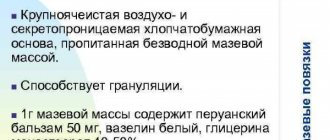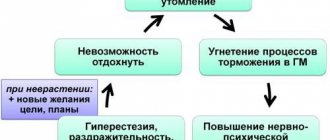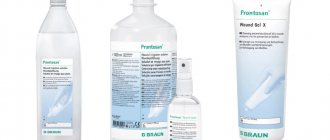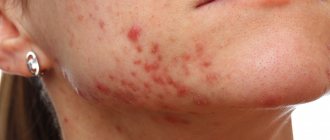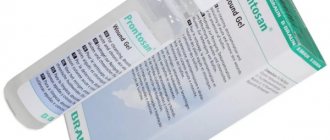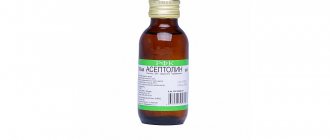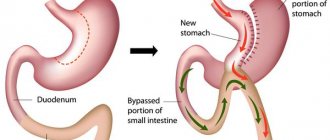Plasters for securing bandages
Not all specialized dressings have an adhesive layer along the edge. To completely cover a large wound with a bandage, you can use roll-on patches made of non-woven material.
Trade names:
- Omnifix
Omnifix patch. Photo: medicaland.ru
- Plastofix
Plastofix patch. Photo: avatars.mds.yandex.net
- LEIKO bandage
LEIKO bandage. Photo: www.ukazka.ru
- Curafix H
Curafix H dressing. Photo: www.netran.ru
Ointment mesh dressings
Mesh dressings are mesh of varying thickness, coated with ointments with different effects. Such dressings do not absorb exudate (liquid that is released from tissues), but can perfectly maintain a moist environment. This prevents the wound from drying out and protects it from sticking. The dressings can be used either alone or in combination with other dressings, such as simple gauze bandages.
In this case, you can put a mesh bandage on the bottom of the wound, and use gauze or other dressings to absorb the discharge from above.
Most often, ointment mesh dressings are used to treat superficial smooth wounds and grade 2 bedsores.
- Coloplast Physiotulle® Ag
Coloplast Physiotulle® Ag. Photo: www.mystoma.ru
- Branolind N dressing
Branolind N/Branolind N. Photo: www.eapteka.ru
- Ointment dressing "Voskopran" with dioxidine
Voskopran with dioxidine. Photo: mednabor.ru
- Parapran dressing with chlorhexidine
Parapran with chlorhexidine. Photo: www.netran.ru
- JELONET
JELONET/JELONET. Photo: invimed.ru
- Bactigras dressing
Bactigras dressing. Photo: www.aramed.ru
- Voskopran Povidone-Iodine dressing
Voskopran Povidone-Iodine dressing. Photo: www.netran.ru
- Atrauman Ag (Atrauman Ag)
Atrauman Ag. Photo: rekate-medical.ru
- Lomatuell H
Lomatuell H. Photo: rekate-medical.ru
Hydrocolloid dressings
Trade names:
- granuflex;
- DuoDerm;
- Suprasorb H;
- Hydrocoll;
- Hydrocoll Sacral;
- Tegaderm Hydrocolloid;
- Comfeel Plus.
The coating base of hydrocolloid dressings consists of microgranules of sodium salt, pectin and gelatin. Such headbands began to be used in the early 80s and they are still one of the most popular.
The dressing can absorb a small amount of discharge from the wound, retains a moist environment well and converts excess moisture into a gel.
Hartmann bandages. Photo: www.mystoma.ru
Turning into a gel, the hydrocolloid acquires a characteristic, not very pleasant odor and a yellow color, which can be mistaken for pus. Therefore, this dressing should not be used on infected, inflamed wounds or wounds with a large amount of discharge. It simply cannot cope with such a volume of liquid and bacteria and will quickly melt. But for superficial, shallow wounds with a small amount of discharge, hydrocolloid dressings are perfect.
Bandage. Photo: cdn.diacheck.ru
Some bandages are made in a special shape to make it easier to stick to certain places where bedsores form (sacrum, elbows, knees, etc.).
Specially shaped bandage. Photo: prozabota.ru
Sponge dressings
Sponge dressings are made of polyurethane foam material with large pores. They can quickly absorb large amounts of discharge and retain it, which reduces irritation of the tissue around the wound. Sponge dressings come with an adhesive edge (adhesive) - they themselves stick to the body and do not require additional fixation with adhesive tape. And not adhesive - they must be additionally secured with a plaster or fixing bandage.
Used for non-infected wounds. In the presence of inflammation and infection, bandages or ointments with an antibiotic, antiseptic or silver-based are added to them. These dressings are covered with a vapor-permeable layer on top, which allows the wound to “breathe” but protects it from external influences.
Many dressings additionally have a wound coating with silicone or hydrogel. This is necessary so that they do not stick to the wound and retain moisture better.
- Coloplast Non-adhesive sponge dressings with Biatain®Ag silver
- Coloplast Adhesive Biatain® sponge heel dressings
Beataine bandage. Photo: medkalopriemniki.ru
- Self-adhesive sponge dressing with hydrogel coating HydroTac Comfort
HydroTac Comfort bandage. Photo: www.careproducts.ru
- Adhesive dressing Suprasorb P Silicone
- Mepilex Ag sponge bandage with silver antibacterial
Mepilex Ag sponge bandage with silver is antibacterial. Photo: www.netran.ru/
- Permafoam comfort sponge self-adhesive dressing
Permafoam comfort. Photo: images.ru.prom.st
- Neofix FibroSorb Ag (Neofix FibroSorb Ag)
Neofix FibroSorb Ag (Neofix FibroSorb Ag). Photo: rekate-medical.ru
- Askina Transorbent (sterile sponge dressing with hydrogel layer)
Askina Transorbent. Photo: rekate-medical.ru
Alginate dressings
These dressings are made from seaweed and are similar in structure to glass wool. The dressings contain calcium or sodium alginate, which turns into a gel upon contact with liquid.
Alginates are natural polysaccharides. The main source of alginates in nature is seaweed of the genus Laminaria, where they are contained in the form of alginic acid salts, mainly sodium alginate.
These dressings are suitable for use in deep wounds and pockets. They perfectly absorb large amounts of liquid and bacteria. In the form of a gel, they do an excellent job of soaking necrosis, fibrin and crusts of dead tissue. That is why such dressings are used to treat bedsores and chronic wounds of 3-4 degrees.
Diaper rash and bedsores: how to treat at different stages In what places do bedsores form, and in which diaper rash, how to treat them depending on the stage Olga OsetrovaTatyana Parfenova
Symptomatic treatment
Nowadays such bandages are made with reinforcement. This is necessary so that the alginate particles do not disintegrate and remain in the wound. If using a non-reinforced dressing, the wound can be irrigated to remove alginate particles. Alginate is not absorbed and is quickly washed off with saline solution.
The alginate dressing must be secured on top with another dressing. It can be a film bandage, hydrogel or sponge. The alginate dressing can also be covered with napkins and secured with a self-adhesive bandage.
If you are using an alginate dressing on a very wet wound, it can be used dry. If the wound is dry and covered with necrosis, then the alginate is pre-moistened with saline solution. This is necessary to restore a moist environment to the wound.
- Algisite M
Algisite M. Photo: www.aramed.ru
- Alginate dressing Suprasorb A
Alginate dressing Suprasorb A. Photo: www.bonanzamarket.co.uk
- Medisorb A
Medisorb A. Photo: www.eapteka.ru
- Algitek S silver bandage
Algitek S silver bandage. Photo: mtkimpex.ru
Usage
It is important to choose the right cosmopore dressing according to the size of the wound. When applying the patch, the following recommendations must be observed:
- Holding the package with the patch by the edges, you must carefully open it.
- The patch should be removed from the packaging, and then the paper layer on one side should be removed.
- The bandage is carefully fixed on the edge of the wound and smoothed, lightly pressing the skin.
- After this, the paper layer on the other side of the bandage is removed and complete fixation is performed.
It is important that the pad, which is located in the center of the bandage, completely covers the wound. The timing of replacing the patch depends on the nature of the damage. But at the same time, the procedure should be carried out at least once every 3 days. The timing of replacing the cosmopore dressing is affected by the size of the wound and the volume of discharge. In addition, the location of the damage should be taken into account.
Hydroactive dressings (solution activated dressings)
The coating of these dressings consists of sodium salt fibers and carboxymethylcellulose, which upon contact with wound secretions turn into a transparent gel. It creates a moist environment on the surface of the wound and does not stick to the wound.
Aquacel Extra
Aquacel Extra. Photo: cdnx.jumpseller.com
HydroClean plus - dressings with active Ringer's solution
The bandage inside contains a gel that has absorbed Ringer's solution. Ringer's solution is a saline solution that draws out drainage and pus from a wound. It absorbs the exudate, and Ringer's solution washes the wound. Works great on dry wounds with necrosis. Cleans wounds containing pus and dead tissue.
HydroClean plus. Photo: prom.ua
Patch
One of such effective and simple means for caring for damaged skin is the sterile self-adhesive postoperative plaster “Cosmopore E”. It is a rectangular bandage with adhesive edges and a soft, moisture-absorbing pad in the middle. The patch performs several tasks:
- Prevents access to the wound by pathogenic microorganisms.
- Protects skin from irritation and mechanical damage.
- Absorbs wound secretions while allowing the skin to breathe, which promotes rapid healing.
The Cosmopore E patch is easy to use and can be used not only in medical institutions, but also at home. After all, it is considered universal and helps not only after operations, but also in case of household injuries.
Hydrogel dressings
Transparent hydrogel dressings provide long-lasting wound hydration due to their high water content, about 60%. These dressings are used to moisturize smooth, dry, uninfected wounds with little discharge.
Bandage on the wound. Image: www.mystoma.ru
The hydrogel is also produced in the form of a tube or syringe, from which it is convenient to squeeze it into deep wounds and pockets. It fills the wound, supplies it with fluid, prevents it from drying out and rejects dead tissue. This gel can be easily washed off with saline solution when dressing. It can remain in the wound for up to 4 days. The gel is used only in those wounds where there is necrosis and fibrin - black and yellow dry crusts and films. It is not used on ordinary clean wounds, as it greatly softens the tissue, and in the case of a clean wound this is not necessary.
- Hydrogel dressing with lidocaine Gelepran
Gelepran. Photo: lan-med.ru
- Phleboton - hydrogel bandage
Phleboton. Photo: rekate-medical.ru
- Hydrosorb Comfort is a self-adhesive hydrogel dressing.
Hydrosorb Comfort/Hydrosorb Comfort. Photo: fortemed.ru
- Hartmann Gidrotak Transparent hydrogel dressing
Hartmann Hydrotak Transparent. Photo: apteka-sale.ru
- Aquabint
Aquabint Oval. Photo: apteka.ru
- Matopat Medisorb G hydrogel dressing
Matopat Medisorb G hydrogel dressing. Photo: www.eapteka.ru
- Hydrosorb Gel
Hydrosorb Gel. Photo: orto-nova.ru
- Gel Suprasorb G
Gel Suprasorb G. Photo: www.netran.ru
- Purilon gel
Purilon gel. Photo: medmag24.ru
- Neofix FibroGel Ag
Neofix FibroGel Ag. Photo: rekate-medical.ru
- Hydrogel Intrasite Gel Applipak
Hydrogel Intrasite Gel Applipak. Photo: www.netran.ru
Types of Cosmopor gaskets and prices
Postoperative sterile and non-sterile dressings Cosmopore are produced by the German company Hartman, which is known for its high-quality, innovative, hygienic and medical products.
The company produces several types of dressings:
- Cosmopore E. These self-adhesive dressings of various sizes are effectively used to close open wounds after surgery. They have an increased absorbent effect, are well fixed on wound areas, and are absolutely painless when removed;
- Cosmoport Advance. Very soft self-adhesive bandage. It has an absorbent, capacious, three-layer, absorbent pad. It is used as a dressing for postoperative wounds and wound skin-superficial areas with increased sensitivity to pressure;
- Cosmopore Antibacterial. A series of antibacterial self-adhesive sterile patches equipped with a layer of silver ions. Used to protect wounds from infections;
- Hydrofilm patch. Self-adhesive adhesive bandage, with a semi-permeable film, resistant to the penetration of water and microorganisms. Sticks to dry postoperative wounds and shallow superficial wounds;
- Omnifix Elastic. The bandage is in the form of a rolled non-sterile plaster, the manufacture of which uses white non-woven material. This patch securely fixes cannulas, bandages, and catheters. The airtightness and elasticity of the patch allows it to be attached to moving surfaces. They also attach probes well;
Cosmopor IV dressing with built-in catheter - Cosmopore I-V headband. Used as a fixator for catheters and cannulas.
| Types of Cosmopor dressings and average prices in Russia | ||
| Episode title | Purpose | Prices in pharmacies for 1 pack. |
| Cosmopore E | Open postoperative wounds. | from 220 to 1292 rub. |
| Cosmopore Advance | Soft plaster for pressure sensitive wounds. | from 447 to 1,785 rubles. |
| Cosmopore Antibacterial | Protecting wounds from infections. | from 493 to 1,148 rubles. |
| Hydrofilm patch | Dry post-operative and small cuts. | from 754 to 2356 rub. |
| Omnifix Elastic | Attaching catheters, cannulas and probes. | from 150 to 1030 rub. |
The Cosmopore patch is convenient to use both in hospital settings and at home without medical assistance. The bandage has unique properties. It is equally effectively used for domestic and post-operative wounds.
The absence of contraindications allows the bandage to be used by children, pregnant or breastfeeding women. In addition, it is effectively used in post-operative cases.
When attaching the bandage, the cotton pad should completely cover the wound area. Therefore, when choosing, you need to select a dressing size comparable to the size of the wound. The interval for changing dressings must be observed. It needs to be changed once every three days. If you do this less often, the wound may become inflamed and suppuration of the affected area may develop.
Absorbent dressings
Absorbent dressings are often used on wounds that are very wet and have a lot of drainage. Such dressings help to cope with the unpleasant odor of infected wounds and wounds with tumor decay. They contain superabsorbents and silver.
- CARBONET (Carbonet) - absorbent deodorizing non-adhesive dressing with activated carbon
CARBONET (Carbonet). Absorbent deodorizing non-adhesive dressing with activated carbon. Photo: rekate-medical.ru
- Absorbent bandage Mesorb
Absorbent bandage Mesorb. Photo: ukrmedshop.ua
- Zetuvit E steril dressing
Zetuvit E steril dressing. Photo: www.deznet.ru
- Askina Calgitrol Ag
The combined dressing consists of a sponge layer, alginate and silver. Absorbs exudate well, reduces odor, and maintains a moist environment. Used on infected wounds, necrosis.
Askina Kalgitrol Ag. Photo: www.bbraun.ru
Bedsores on the head: prevention and treatment Samara hospice doctors tell how to prevent bedsores on the head of a seriously ill person and what to do if they appear Olga OsetrovaTatyana Parfenova
Symptomatic treatment
Please remember that using modern dressings to treat bedsores does not solve the problem. Bedsores can be successfully treated only when we remove the cause of their occurrence - long-term exposure to body tissue, when a person lies in one position for more than two hours. Without constant changing of posture and correct positioning, no bandage will help cure bedsores.
Indications for use and sizes
Cosmopor medical dressings are widely used in surgical and traumatology practice. They are especially effective in the postoperative period in the presence of discharge and bleeding. In addition, positive results were noted during the use of patches in the treatment of bedsores in bedridden patients, as well as for the treatment of inflamed trophic ulcers. The main areas of use of patches are surgery and traumatology. But the use of “Cosmopor” is also possible at home for various injuries and wounds.
Before purchasing a bandage for self-use, you need to determine the size of the wound in order to choose the right product for yourself. On the shelves of pharmaceutical markets and pharmacies you can find different sizes of Cosmopor patches:
- 7.2 × 5cm;
- 15 × 6 cm;
- 10 × 8 cm;
- 15 × 8 cm;
- 20 × 8 cm;
- 20 × 10 cm;
- 25 × 10 cm;
- 35 × 10 cm.
The packaging must be opened in the place specified by the manufacturer. After this, the patch is carefully removed and attached to the injured area of skin. In this case, the pad should completely cover the wound. The adhesive plaster should be changed individually, but at least once every 3 days.
